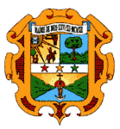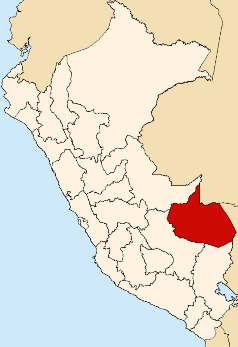Madre de Dios Region
| Madre de Dios Region | |
|---|---|
 coat of arms |
|
 |
|
| See other Peruvian regions | |
| President | Rafael Ríos |
| Capital | Puerto Maldonado |
| Area | 85,300.54 km² |
| Population (as of the 2005 Census) | |
| Population - Total - Density |
92,024 1.1/km² |
| Subdivisions | 3 provinces and 11 districts |
| Elevation - Lowest - Highest |
183 m (Puerto Maldonado) 500 m (Mouth of Manu River) |
| Latitude Longitude |
9º55'33" S to 88883º2004" S 68º39'27" W to 77º22'27" W |
| Main resources | Cotton, coffee, sugar cane, cacao beans, Brazil nuts, palm oil, gold, rice, coconut, wood. |
| Poverty rate | 36.7% |
| Percentage of country's GDP | 0.37% |
| Codes | |
| Dialing code | 082 |
| ISO 3166-2 | PE-MDD |
| UBIGEO | 17 |
| Official website | |
| www.regionmadrededios.gob.pe | |
Madre de Dios is a region in southeastern Peru, bordering Brazil, Bolivia and the Peruvian regions of Puno, Cusco and Ucayali. Its capital is the city of Puerto Maldonado. The name of the region is a very common Spanish-language designation for the Virgin Mary, literally meaning Mother of God.
Contents |
Geography
The region is almost entirely low-lying Amazonian rainforest. The climate is warm and damp, with average temperatures around 26º C (max. 34º C, min 21º C). The rainy season is from December to March, when torrential rainfall causes rivers to swell and often burst their banks. Annual precipitation can be as much as 3 metres.
The south-western boundary with the Cusco Region is known as the Isthmus of Fitzcarrald, a series of small mountains that separate the Madre de Dios River and the Urubamba River.
The most important rivers are those in the Madre de Dios River watershed:
- Inambari River.
- Tambopata River.
- Manu River.
- Tahuanamú River.
- de las Piedras River.
- Heath River.
- Acre River.
Due to the vast size of the area and its low population density, rivers provide the best way of getting from one town to another. Human activity is invariably confined to riverbanks. A number of explorers have searched for the lost city of Paititi in the jungle within the region
The only road of note is between the town of Puerto Maldonado and the city of Cuzco (530 km away in Cuzco Region). However, it is in very poor condition and flights between Cuzco and Puerto Maldonado remain the most common and reliable method of transport between the two. From Puerto Maldonado there is a road to the mining town of Laberinto ("Labyrinth") (about 50 km long). A second road is between the village of Atalaya and Cuzco. It is a roughly 300 km long single track road that is impassable in the rainy season.
Economy, Natural Resources and Environment
Madre de Dios depends heavily on natural products and raw materials for its economy. There is virtually no manufacturing industry. The main agricultural products are:
Gold mining is the only other large industry of the region, confined mainly to the beaches of the Inambari and Madre de Dios Rivers. Contrary to recent propaganda, this presents both a major environmental and public health problem. Most gold miners use liquid mercury to extract gold particles from the river silt. They often handle the toxic liquid mercury with their bare hands. To purify the gold particles, the mercury is burned off. After being vaporized, mercury particles contaminate the surrounding ecosystems. Mercury bioaccumulates throughout the food chain to become concentrated in top predators such as large river fish and carnivorous birds. Exposure to or the ingestion of mercury have been shown to result in a variety of neurological and congenital health problems.
Other serious environmental problems in the region include loss of forest cover for agriculture, illegal selective logging (particularly for mahogany) and illegal poaching of endangered species (particularly the Giant River Otter, Amazonian turtles, caimans, and monkeys and macaws as pets).
The national bird of Peru, the Andean Cock-of-the-rock, is also found in Madre de Dios and suffers from poaching and habitat disturbance.
Political division
The region is divided into three provinces (provincias, singular: provincia), which are composed of 11 districts (distritos, singular: distrito). The provinces, with their capitals in parenthesis, are:
- Manu (Salvación)
- Tahuamanu (Iñapari)
- Tambopata (Puerto Maldonado)
Popular Culture
In the novel Primeval: Shadow of the Jaguar most of the story takes place in Madre de Dios, where a time anomaly has opened and let a pack of prehistoric Thylacosmilus into the modern world. The region is claimed to be home to many ancient Inca ruins, several jungle tribes and endnagered species like the capybara, jaguar and giant river otter.
See also
- Julio Cusurichi Palacios
External links
|
||||||||